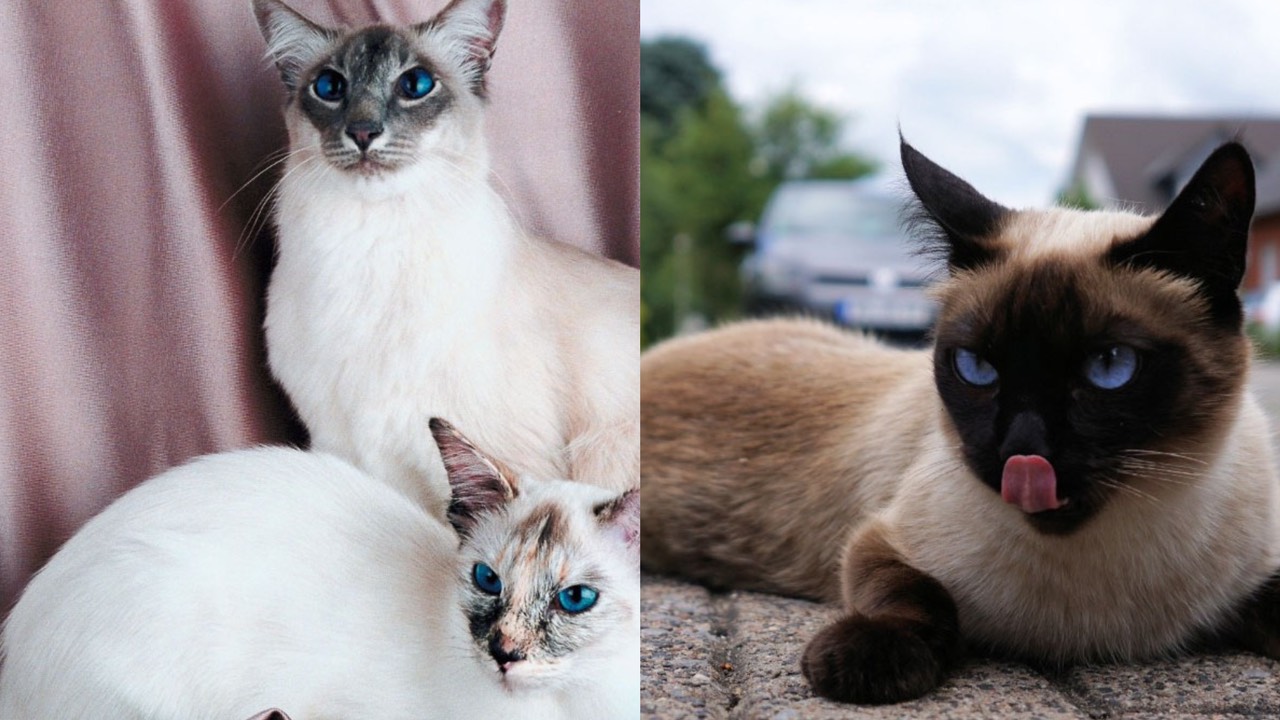
Everyone loves Siamese cats—they’re friendly, loyal, sociable, active, and super clever. These adorable cats also have a distinctive, sought-after appearance that sets them apart from other breeds.
They have a distinct personality that makes these beauties even more special. They feature a perfect dark face flawlessly merged into an off-white furry coat. They also possess a famous and captivating pair of blue eyes.
When you adopt a new cat, you never expect your cat’s fur to change in color—you expect the coat color of your cat to stay the same throughout his entire life, but as odd as it might seem, this is not the case in Siamese cats! Do Siamese cats fur change color?
Read on as we cover everything you need to know about the furry coat of Siamese cats!

You might enjoy reading more of my articles on Siamese Cats: Siamese Cat Personality, Types of Siamese Cats, Siamese Cats, Are Siamese Cats good mousers?, Why do Siamese Cats meow so much?, When do Siamese cats stop growing, Siamese Munchkin Cat, Are Siamese Cats mean?, Do Siamese Cats shed?, How big do Siamese Cats get?, Why does my Siamese Cat attack me?, Siamese Cats in Heat, Signs my cat is a Siamse Mix and Male vs Female Siamese Cats.
A Siamese cat’s points become darker as the temperature rises, and the actual color that manifests is determined by genetic coding. The four colors in purebred Siamese cats are chocolate point, lilac point, blue point, and seal point.
Cinnamon, lynx, caramel, fawn, tortoiseshell, cream, apricot, tabby, and red are additional point colors that are the outcome of breeding programs.

Want to learn more about the fascinating colors of Siamese cats? Then you should check our comprehensive article about the 13 Most Popular Siamese Cat Colors!
The simple answer to this question is yes. There are six factors that will influence how the color of your siamese cat’s fur changes.
The temperature of a Siamese cat’s skin directly impacts the color of its coat. For example, if the weather is warm, Siamese can better maintain the pale color of its coat. The white color of Siamese kittens thus makes sense because these little beauties spend nine weeks growing in their mommy’s warm womb. The fur of Siamese cats remains white at a temperature of 101⁰ F.
A Siamese kitten’s coat starts to change color at its extremities when it’s one week old since these areas are usually cooler. The color of their face, ears, tail, and legs start to change as their skin temperature drops below 98 °F.

While temperature affects color intensity, genetics determines the color itself. The Himalayan gene, which stops melanin production at temperatures exceeding 98 °F, regulates the color change in Siamese cats.
An enzymatic coat color change that only occurs when the skin temperature drops below 98 F is suppressed by heat. Thus, the extremities grow darker a week after birth while the body and neck remain white.
Siamese cats shed their winter undercoat in spring for a new coat to grow. Cats that live in hot areas with their owners tend to have lighter summer coats due to the high temperatures.
On the other hand, the winter coat of Siamese cats appears in fall, and Siamese cats that live in colder areas with their owners tend to have darker coats due to the low temperatures.

Your Siamese cat will appear darker during winter, and as the weather warms up, it will appear lighter—this is just how it works!
Expect your Siamese cat to appear darker for roughly five months during the year, meaning that during about half of the year, the coat of your Siamese cat will appear darker than it originally was. However, this depends on the climate you and your cat live in and your cat itself because not all Siamese cats change color the same.
The Siamese cat differs from others because it enjoys basking in the sun’s warmth. If your Siamese cat’s points are overexposed to the sunlight, you may notice that some of its black furs turn reddish-brown. This also happens to humans when the sun bleaches out the color of our hair.

But that doesn’t mean that Siamese cats that like to bask in the sun are the only ones prone to color change. If your Siamese cat frequently lays by the window, the sun can still brighten his furry coat through the glass.
If there’s a disruption to the tyrosine metabolism of Siamese cats, the production of melanin is significantly altered. A Siamese cat’s lighter-colored fur is one indication (but not the only one) that its tyrosine metabolism is dysfunctional.
Cats typically require twice as much phenylalanine and tyrosine to generate the regular dark color—a reduction in these amino acids results in a lighter color.

Any cat’s nutrition affects how he looks outside, and Siamese cats are no exception. Normal tyrosine levels are important for the body of your Siamese cat to produce the desired amount of melanin. The cat’s coat turns rusty when there isn’t enough in the body.
The best way to keep the tyrosine levels of your cat balanced is to feed him high-quality cat food, or you could prepare it yourself with love for your cat, but make sure to follow the guidelines prescribed by your vet to a tee. Your Siamese cat’s food should contain all the necessary vitamins, minerals, fats, carbs, and proteins to ensure that he changes color normally.

The color of your Siamese cat might change as he ages. Siamese cats are born with a certain color that stays throughout adulthood, but it might change a little bit as they get older.
You may be surprised that Siamese gradually develops gray hairs with age like humans. But it would be hard to notice them if your Siamese cat has a fluffy white coat! These are difficult to see on your Siamese’s body but are much easier to see on his face.

White also appears on your cat’s snout, which is common among all cats, especially Siamese cats. Unlike humans, Siamese cats don’t usually turn completely white—you can only see some hairs that lose their pigment while others don’t.
While it sounds unusual, the coat of a Siamese cat can get darker instead of lighter as they age. But it makes a lot of sense. Let us explain.
Because there’s less blood flow, Siamese cats turn darker as their body temperature drops. This occurs specifically where seal-point Siamese cats are darker, such as the tail, ears, and snout.
You’d be absolutely surprised to learn that Siamese cats keep changing color throughout their entire life! This is simply because the Himalayan gene keeps doing its magic from the moment they’re born until its life ends. This is also the reason why the Thai breed becomes darker every month.
While the aging process of your Siamese cat cannot be reversed, you still have control over other elements like your cat’s diet. You want to provide your Siamese cat with all the nutrients it needs to stay healthy and not abnormally change color. You also want professional help to ensure that your cat doesn’t have any of the health issues mentioned above.
Finally, you can limit your Siamese cat’s exposure to sunlight. But other than that, let your Siamese cat be a Siamese cat!

This post about do siamese cats fur change color may contain affiliate links. This means if you click through and end up making a purchase I may receive a small commission. Just wanted to make sure you knew this.






